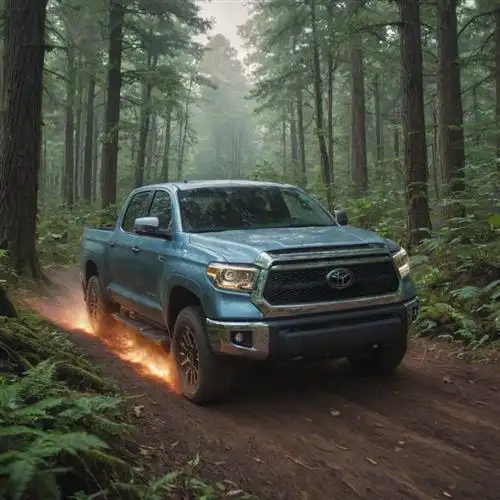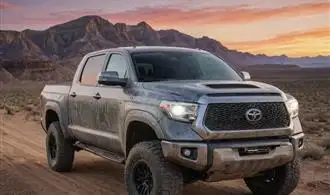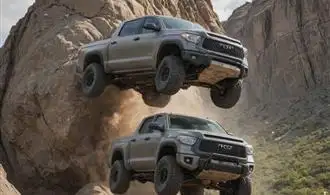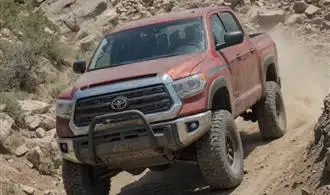
Understanding the Basics of Tundra Tuning
Tuning your Toyota Tundra can be a delicate balance between unleashing its full potential and maintaining its performance integrity. It's essential to approach the process with a keen understanding of the underlying mechanics and the potential implications of each modification. In this section, we'll explore the fundamental aspects of Tundra tuning, equipping you with the knowledge to navigate this journey confidently.
At the core of Tundra tuning lies the engine, the heart of your vehicle. Optimizing the engine's performance requires a comprehensive understanding of its components and their interplay. This includes the intake system, exhaust system, engine management software, and any forced induction components, such as turbochargers or superchargers. Each of these elements plays a crucial role in determining the engine's power output, efficiency, and responsiveness.
When it comes to the intake system, a well-designed aftermarket air intake can significantly improve airflow, leading to increased horsepower and torque. However, it's crucial to ensure that the new intake system is compatible with your Tundra's engine and doesn't compromise the delicate balance of the factory setup. Improper modifications can result in issues such as reduced fuel efficiency, increased emissions, or even engine damage.
The exhaust system is another critical component in Tundra tuning. A high-performance exhaust system can enhance the engine's breathing, reducing backpressure and allowing for more efficient expulsion of exhaust gases. This, in turn, can translate to increased power and a more responsive driving experience. However, it's essential to strike a balance between performance and noise levels, as some exhaust modifications may result in excessive noise that could be illegal or undesirable in certain areas.
Engine management software is the brain of your Tundra, responsible for controlling various aspects of engine operation, including fuel delivery, ignition timing, and more. Tuning the engine management system can unlock additional power and torque, but it requires a deep understanding of the underlying algorithms and the potential consequences of such modifications. It's highly recommended to work with a reputable tuning shop or experienced professional to ensure that the engine management tuning is done safely and in compliance with any applicable regulations.
Forced induction systems, such as turbochargers or superchargers, can dramatically increase the Tundra's power output. However, these modifications require careful planning and execution to maintain the engine's reliability and longevity. Proper tuning of the forced induction system, including the wastegate or supercharger pulley, is crucial to prevent issues like excessive boost, detonation, or premature wear of engine components.
Maximizing Horsepower and Torque
Maximizing Horsepower and Torque in Your Toyota Tundra is a delicate balance that requires precision and expertise. One of the key factors in achieving optimal performance is the engine tuning process. By carefully adjusting the various parameters of your Tundra's engine, you can unlock its true potential and experience a noticeable boost in both horsepower and torque.
The first step in this process is to understand the importance of air intake and exhaust systems. Upgrading these components can significantly improve the flow of air in and out of the engine, allowing it to breathe more freely and generate more power. This can be achieved through the installation of high-performance air filters, cold air intakes, and aftermarket exhaust systems that reduce backpressure.
Another critical aspect of engine tuning is the optimization of fuel delivery. By adjusting the fuel injector size, fuel pressure, and fuel mapping, you can ensure that the engine is receiving the perfect air-fuel mixture for maximum combustion efficiency. This not only enhances horsepower but also improves fuel economy and reduces emissions.
Ignition timing is another crucial factor in tuning your Toyota Tundra. Proper ignition timing ensures that the spark plugs fire at the optimal moment, allowing the fuel-air mixture to burn completely and efficiently. Adjusting the ignition timing can have a dramatic impact on both horsepower and torque, so it's essential to work with a skilled technician who understands the intricacies of your Tundra's engine.
In addition to these engine-specific modifications, the suspension and braking systems also play a crucial role in maximizing the performance of your Toyota Tundra. Upgrading components like shocks, springs, and brake pads can improve handling, stability, and responsiveness, enabling you to harness the full potential of your Tundra's power. As mentioned in the article "Experts Reveal the Secrets of Toyota Tundra Customization," these customization options can have a significant impact on the overall driving experience.
Improving Handling and Braking
Optimizing the handling and braking performance of your Toyota Tundra is crucial for a safe and enjoyable driving experience. One key aspect is upgrading the suspension components. Investing in high-quality shocks, struts, and coil springs can dramatically improve the truck's responsiveness, stability, and control. Look for components designed specifically for the Tundra that can handle the vehicle's weight and terrain demands.
Brake upgrades are another essential modification. The stock Tundra brakes may struggle under heavy loads or aggressive driving. Consider installing larger, performance-oriented brake rotors and calipers. Upgrading the brake pads to a high-friction compound can also enhance braking power and fade resistance. Remember to properly break in any new brake components to ensure optimal performance and longevity.
Addressing the Tundra's tire setup is crucial for handling and braking improvements. Opt for tires with a stiffer, performance-oriented tread pattern and compound. This can provide better grip, reduced rolling resistance, and improved cornering capabilities. Ensure the tires are properly inflated to the manufacturer's recommended pressures to maximize their potential.
Adjusting the Tundra's alignment is another valuable modification. Proper wheel alignment ensures the tires are tracking straight and the suspension components are working in harmony. This can enhance stability, reduce tire wear, and improve overall handling characteristics. Consider having a professional alignment specialist evaluate and adjust your Tundra's alignment to optimize performance.
Balancing Performance and Fuel Efficiency
Tuning your Toyota Tundra is a delicate balancing act between performance and fuel efficiency. While it's tempting to simply chase raw power, the reality is that many modifications can negatively impact your truck's fuel economy. The key is finding the right combination of upgrades that allow you to enjoy the increased performance you desire without sacrificing too much at the gas pump.
One of the most important factors to consider is the engine. Upgrades like cold air intakes, performance exhaust systems, and engine tuning can certainly boost power, but they also tend to increase fuel consumption. The trick is to find a balance - maybe an intake and exhaust system that offer a modest power increase without drastically reducing efficiency. Avoid overly aggressive engine tunes that prioritize horsepower over fuel economy.
Transmission upgrades can also play a role in this equation. Swapping to a higher-performance transmission with more gears can help optimize power delivery while maintaining reasonable fuel efficiency, especially on the highway. Just be sure not to choose a setup that's so aggressive it becomes unlivable in daily driving.
Suspension modifications are another area where you'll need to strike a careful balance. Upgrading to lifted shocks and larger tires may look tough and enhance off-road capability, as described in How to Modify Your Toyota Tundra for Epic Off-road Adventures, but these changes can also increase rolling resistance and wind drag, hurting fuel mileage. Consider more moderate lift kits and tire sizes to find the sweet spot.
Protecting Your Tundra's Performance Upgrades
Tuning your Toyota Tundra can unlock exceptional power and capability, but it's crucial to protect your investment. Improper modifications can compromise your truck's performance, reliability, and even safety. As a professional content writer, I'll guide you through the steps to safeguard your Tundra's upgrades and ensure optimal performance.
One of the most critical aspects of protecting your Tundra's performance is maintaining a balanced and cohesive system. Avoid mixing and matching incompatible components, as this can lead to unintended consequences. Ensure that any new parts, such as air intake systems, exhaust upgrades, or engine modifications, work seamlessly together to enhance, not hinder, your Tundra's capabilities.
Proper installation is equally important. Enlisting the help of a skilled mechanic or technician can make all the difference. They possess the expertise to properly integrate performance upgrades without compromising your Tundra's safety or reliability. Cutting corners or attempting DIY installations without the necessary knowledge can result in costly and potentially dangerous issues down the line.
Another crucial aspect of protecting your Tundra's performance is regular maintenance and monitoring. Closely track your vehicle's behavior, noting any changes in fuel efficiency, power delivery, or overall responsiveness. Be proactive in addressing any concerns, as ignoring potential problems can quickly escalate and lead to more significant issues.
Regular maintenance, such as oil changes, fluid flushes, and inspections, is paramount. Ensure that you're using the correct fluids, filters, and components recommended by the manufacturer or your trusted mechanic. Neglecting these essential maintenance tasks can compromise the longevity and performance of your Tundra's upgrades.
It's also essential to consider the environmental conditions in which you operate your Tundra. Extreme temperatures, off-road conditions, or even daily driving can put additional stress on your vehicle's components. Adapting your driving style and maintenance schedule to accommodate these factors can help mitigate the risk of premature wear or failure.
















